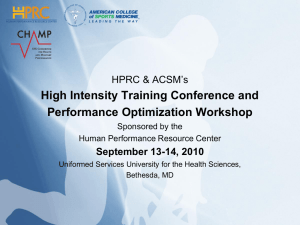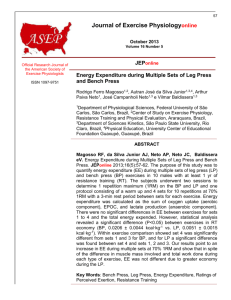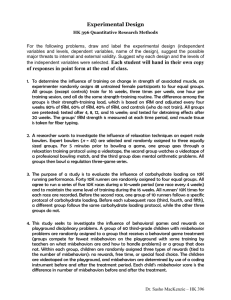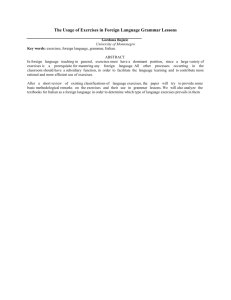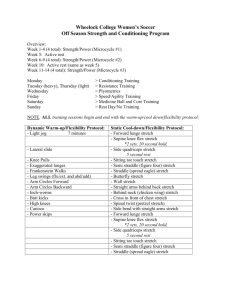Words - American Society of Exercise Physiologists
advertisement
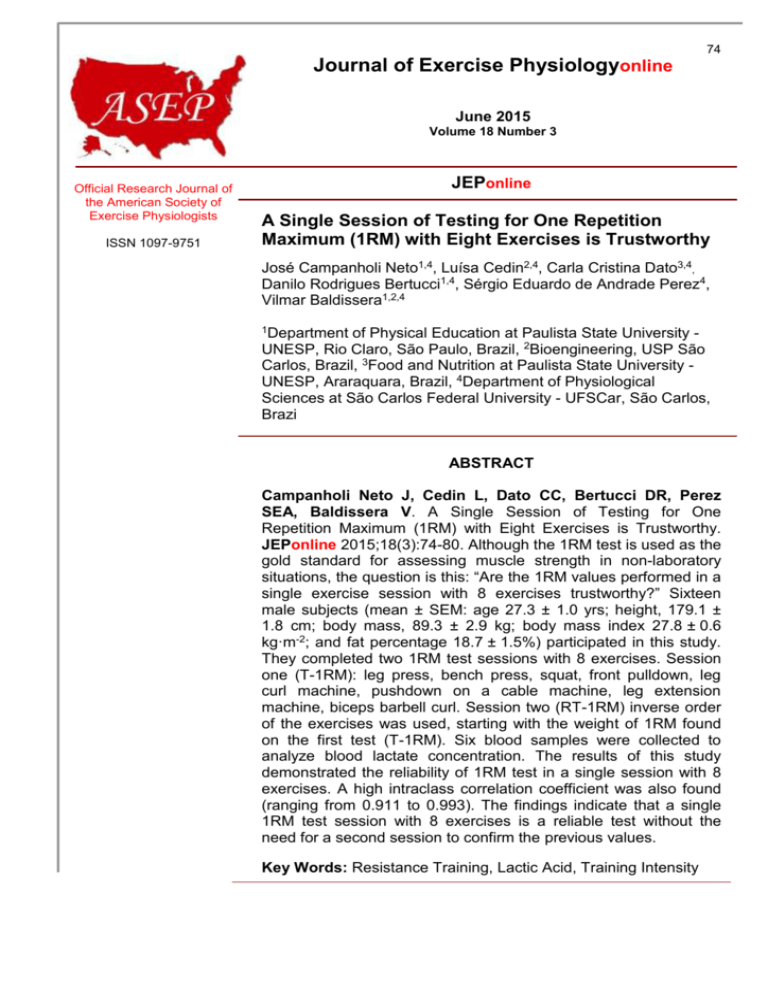
74 Journal of Exercise Physiologyonline June 2015 Volume 18 Number 3 Editor-in-Chief Official Research Journal of Tommy the American Boone, PhD, Society MBA of Review Board Exercise Physiologists Todd Astorino, PhD Julien Baker, ISSN 1097-9751 PhD Steve Brock, PhD Lance Dalleck, PhD Eric Goulet, PhD Robert Gotshall, PhD Alexander Hutchison, PhD M. Knight-Maloney, PhD Len Kravitz, PhD James Laskin, PhD Yit Aun Lim, PhD Lonnie Lowery, PhD Derek Marks, PhD Cristine Mermier, PhD Robert Robergs, PhD Chantal Vella, PhD Dale Wagner, PhD Frank Wyatt, PhD Ben Zhou, PhD Official Research Journal of the American Society of Exercise Physiologists ISSN 1097-9751 JEPonline A Single Session of Testing for One Repetition Maximum (1RM) with Eight Exercises is Trustworthy José Campanholi Neto1,4, Luísa Cedin2,4, Carla Cristina Dato3,4, Danilo Rodrigues Bertucci1,4, Sérgio Eduardo de Andrade Perez4, Vilmar Baldissera1,2,4 1Department of Physical Education at Paulista State University UNESP, Rio Claro, São Paulo, Brazil, 2Bioengineering, USP São Carlos, Brazil, 3Food and Nutrition at Paulista State University UNESP, Araraquara, Brazil, 4Department of Physiological Sciences at São Carlos Federal University - UFSCar, São Carlos, Brazi ABSTRACT Campanholi Neto J, Cedin L, Dato CC, Bertucci DR, Perez SEA, Baldissera V. A Single Session of Testing for One Repetition Maximum (1RM) with Eight Exercises is Trustworthy. JEPonline 2015;18(3):74-80. Although the 1RM test is used as the gold standard for assessing muscle strength in non-laboratory situations, the question is this: “Are the 1RM values performed in a single exercise session with 8 exercises trustworthy?” Sixteen male subjects (mean ± SEM: age 27.3 ± 1.0 yrs; height, 179.1 ± 1.8 cm; body mass, 89.3 ± 2.9 kg; body mass index 27.8 ± 0.6 kg·m-2; and fat percentage 18.7 ± 1.5%) participated in this study. They completed two 1RM test sessions with 8 exercises. Session one (T-1RM): leg press, bench press, squat, front pulldown, leg curl machine, pushdown on a cable machine, leg extension machine, biceps barbell curl. Session two (RT-1RM) inverse order of the exercises was used, starting with the weight of 1RM found on the first test (T-1RM). Six blood samples were collected to analyze blood lactate concentration. The results of this study demonstrated the reliability of 1RM test in a single session with 8 exercises. A high intraclass correlation coefficient was also found (ranging from 0.911 to 0.993). The findings indicate that a single 1RM test session with 8 exercises is a reliable test without the need for a second session to confirm the previous values. Key Words: Resistance Training, Lactic Acid, Training Intensity 75 INTRODUCTION Among the modalities of physical exercise, resistance training (RT) is an integral component of an exercise program. Whether it is the resistance generated by one’s own body weight or equipment such as dumbbells and/or specific machines, there is an inverse relationship between the amount of weight lifted and the number of repetitions (9). The strength training literature is often based on a percentage of one repetition maximum (1RM) in order to define the intensity of training by exercise physiologists, rehabilitation specialists, and strength coaches (1,16). Changes in the RT intensity of exercise can be used to improve muscular endurance, hypertrophy, strength, and muscle power (1,20). Moreover, it is considered the gold standard for assessing muscle strength in non-laboratory situations (8,15). Nevertheless, the practice of one repetition maximum test (T-1RM) is still of little use by fitness professionals, athletic trainers, and strength coaches. Protocols consist of only one exercise per day or made in different times and intervals higher than 24 hrs in order to avoid a possible neural fatigue (4,10). Thus, the practice of T-1RM can be an unviable strategy for strength coaches and other fitness professionals. However, the values found in T-1RM are of fundamental importance to determining the zones of intensity in RT (1,2). Other forms of obtaining 1RM using prediction equations aimed at estimating maximal strength were utilized in other works, but to determine, with efficiency, the intensity of the exercise it is necessary to use T-1RM instead of prediction equations (12,17). However, the question is this: “Are the 1RM values realized in only one session with 8 exercises trustworthy?” For reliability purposes, the current study tested the validity of 1RM Test while also analyzing the subjects’ Blood Lactate Concentration (BLC) during a single session with 8 exercises. METHODS Subjects Sixteen healthy, male subjects (mean ± SEM: age 26.9 ± 1.0 yrs; height, 179.1 ± 1.9 cm; body mass, 89.0 ± 3.1 kg; body mass index 27.7 ± 0.6 kg·m-2; body fat percentage 18.7 ± 1.7%) provided informed consent to take part in the study. Exclusion criteria were: (a) not practicing RT in the last 3 months at a minimum frequency of 3 d·wk-1; and (b) use of any nutritional and/or pharmacological ergogenic aids. All subjects were considered able in the Physical Activity Readiness Questionnaire PAR-Q (18). The study was conducted according to the declaration of Helsinki, and ethical approval was granted by the ethics committee of the Federal University of São Carlos, São Paulo, Brazil (CEP/UFSCar n° 434.096 - 15/10/2013). Procedures The study was performed in three separate days, with minimum 72 hrs and maximum 120 hrs rest between them. On the first day the subjects were assessed for height, weight, and body fat percent based on skinfold (14). Also, for food intake supervision, three 24-hr recordatories (R24hs) were made (5). Food control was performed to maintain a feeding pattern during the study. T-1RM (second day): each subject was tested in the following order: leg press 45°, smith machine bench press, smith machine half-squat, front pulldown, leg curl, elbow extension, leg extension, and biceps barbell curl. Retest session (RT-1RM) took place on the third day. An inverse order of the exercises was used, starting with the weight of 1RM found on the first test (T-1RM). The reverse order was chosen to minimize the possible fatigue in the last exercises performed during T-1RM. 76 One-Repetition Maximum Test Each 1RM test session was preceded by a dynamic warm-up of 3 min of light cycling on a stationary bike at 75 W with 65 to 70 rev·min-1 (Ergo Fit 167, Version 1.27, Ergo Fit, Partner Ihrer Gesundheit®). The starting weight loads were according to the training records of each subject. During each exercise test, if the subject successfully completed the weight loads more than two repetitions, the load was increase. 1RM was defined as the weight load that the subject could successfully raise before the last weight load that he could not raise. Five minutes of rest between each attempt and 2 min between exercise were allowed, as this has been shown to be adequate for phosphocreatine replenishment (4). Blood Lactate Concentration (BLC) During both sessions of 1RM test, six blood samples (25 µL) were collected from the moments: 1 – 5 min before the sessions; 2 – after the second exercise; 3 – after the fourth exercise; 4 – after the sixth exercise; 5 – after the eighth (last) exercise; and 6 – 10 min after the end of the session, using heparinized previously calibrated capillaries (11). BLC was determined by electroenzymatic method with a lactate analyzer (1500 Sport; Yellow Springs Instruments Inc., Yellow Springs, OH), Figures 1 and 2 show the scheme. Figure 1. Moments 1 to 6 of Blood Samples in T-1RM and Exercise and Order of Exercises. Figure 2. Moments 1 to 6 Blood Samples in RT-1RM and Exercise and Order of Exercises. 77 Statistical Analyses Results are expressed as mean ± SEM and confidence interval (CI). Initially, the KolmogorovSmirnov (P>0.05) test was used to analyze variable normality. Normality test failed, thus the Mann-Whitney test was performed (22). Intraclass correlation coefficient (ICC; two-way random model, consistency option, single measures) was calculated to analyze the reliability (19). ICC values of 0.80 and higher were interpreted as large reliability (6). In all cases, a probability level of 95% (P≤0.05) was used for statistical significance. ICC was analyzed using Statistical Package for the Social Sciences (SPSS) version 17, Chicago, USA, 2008 (www.ibm.com) (13). Other tests were analyzed using GraphPad Prism 5.00 for Windows, GraphPad Software, San Diego, CA. RESULTS The 1RM load (kg) for the 8 exercises and the ICC between T-1RM and RT-1RM sessions are presented in Table 1. No statistically significant differences were found for any of the exercises between T-1RM and RT-1RM. The lower ICC presented in the study was 0.9111 for half-squat exercise, demonstrated a large reliability between tests. Figure 3 show low levels in BLC and variation during Sessions T-1RM and RT-1RM. Table 1. 1RM Results in T-1RM and RT-1RM. T-1RM (kg) Exercises CI 𝑥̅ ± SEM RT-1RM (kg) 𝑥̅ ± SEM CI P ICC Leg Press 45° 416.3 ± 13.2 1st 388.2 to 444.4 418.5 ± 11.9 8th 393.1 to 443.9 0.9698 0.963 Bench Press 109.3 ± 4.3 2nd 100.2 to 118.4 107.7 ± 3.9 7th 99.3 to 116.0 0.8026 0.967 141.8 ± 4.1 3rd 132.9 to 150.6 143.3 ± 4.2 6th 134.4 to 152.2 0.7894 0.911 Front Pulldown 94.1 ± 1.9 4th 90.0 to 98.1 94.4 ± 2.0 5th 90.0 to 98.7 0.8603 0.933 Leg Curl 76.4 ± 2.7 5th 70.6 to 82.3 76.8 ± 2.6 4th 71.2 to 82.3 0.9697 0.993 44.7 ± 2.0 6th 40.5 to 48.9 46.8 ± 2.2 3rd 42.1 to 51.4 0.4806 0.956 Leg Extension 102.2 ± 3.5 7th 94.8 to 109.6 104.8 ± 3.8 2nd 96.7 to 112.9 0.5433 0.924 Biceps Barbell Curl 53.4 ± 1.7 8th 49.8 to 57.0 1st 51.8 to 58.9 0.4597 0.943 Half-Squat Pushdown 55.4 ± 1.7 n = 16; 𝑥̅ : Mean; SEM: Standard Error of the Mean; CI: Confidence Interval; ICC: Intraclass Correlation Coefficient; Superscripts 1st to 8th Show the Execution Order of Exercises in Both Test Sessions. Blood Lactate Concentration T-1RM 2.5 2.5 2.0 2.0 1.5 1.5 1.0 1.0 0.5 0.5 0.0 1 2 3 4 5 Collection points 6 B 3.0 A mmol/l mmol/l 3.0 Blood Lactate Concentration RT-1RM 0.0 1 2 3 4 5 Collection points 6 Figure 3. Blood Lactate Concentration during Sessions T-1RM and RT-1RM. Blood Collection Points (1 to 6, Figures 1 and 2); A: T-1RM and B: RT-1RM; n = 16; + = mean; ● = outliers. 78 DISCUSSION 1RM Values One repetition maximum is the object of considerable research, but it is more often than not designed with few exercises (i.e., 2 to 4 per session and, in some cases, the exercises are done on different days (3,12,21). Levinger et al. (15) demonstrated high reliability of 1RM testing on chest press, leg press, lat pull down, triceps push down, knee extension, seated row, and biceps curl in 53 untrained males (n = 25) and females (n = 28) aged 51.2 ± 0.9 yrs, but all sessions were conducted in the same order of exercises. The results of this study demonstrated high reliability of the 1RM Test in a single session with 8 exercises, (ICC ranged from 0.911 to 0.993). The reverse order of the exercises in RT-1RM allowed for the evaluation of the effect of a possible fatigue (that did not occur) during the last exercises of the T-1RM protocol and during the last exercises during the RT-1RM. Blood lactate concentration Highest BLC was found at Point 2 in T-1RM (𝑥̅ ± SEM 2.0 ± 0.1 mmol·L-1) and at Point 5 in RT1RM (𝑥̅ ± SEM 1.8 ± 0.1 mmol·L-1). Both values are below what is typically found at the lactate threshold (i.e., moment where anaerobic lactic becomes metabolically relevant) in RT in other studies (7,16). Oliveira et al. (16) found BLC at the lactate threshold of 2.7 ± 0.3 mmol·L-1 in the bench press and 3.8 ± 0.5 mmol·L-1 in the leg press at 45°. These data show the possibility of applying T-1RM in a single session without requiring action of glycolytic metabolism during the execution. Also, the test allows for calculating the intensity of RT, which is very important for the participants of a very engaging exercise program. CONCLUSIONS The findings indicate that a single 1RM test session with eight exercises is a reliable test without the need for a second session to confirm the previous values. Thus, it is reasonable to conclude the predominance of ATP-phosphocreatine (PC) energy system during the sessions. This finding should prove helpful in the encouragement of exercise physiologists and others (e.g., athletic trainers, rehabilitation specialists, and strength coaches) to use the 1RM test. ACKNOWLEDGMENTS We grateful Coordenação de Aperfeiçoamento de Pessoal de Nível Superior (CAPES) by subsidy. Address for correspondence: Campanholi Neto J, Rua Joaquim Ribeiro Dias, 81, Bom Jesus, Guaranésia, Minas Gerais, Brazil, Zip-code 37810-000. Department of Physical Education at Paulista State University - UNESP, Rio Claro, São Paulo, Brazil, Email: campanholi@ufscar.br References 1. American College of Sports Medicine Position Stand. Progression models in resistance training for healthy adults. Med Sci Sports Exerc. 2009; 41(3):687-708. 2. Barroso R, Silva-Batista C, Tricoli V, Roschel H, Ugrinowitsch C. The effects of different intensities and durations of the general warm-up on leg press 1RM. J Strength Cond Res. 2013;27(4):1009-1013. 3. Benton MJ, Raab S, Waggener GT. Effect of training status on reliability of one repetition maximum testing in women. J Strength Cond Res. 2013;27(7):1885-1890. 79 4. Brown LE, Weir JP. ASEP Procedures Recommendation I - Accurate assessment of muscular strength and power. JEPonline. 2001;4(3):1-21. 5. Buzzard M. 24-hour dietary recall and food record methods. Monographs in Epidemiology and Biostatistics. 1998;(30):50. 6. Cohen J. A power primer. Psychol Bull. 1992;112(1):155-159. 7. Faude O, Kindermann W, Meyer T. Lactate threshold concepts: How valid are they? Sports Med. 2009;39(6):469-490. 8. Fleck SJ, Kraemer W. Designing Resistance Training Programs. Human Kinetics, 2014. 9. Garber CE, Blissmer B, Deschenes MR, Franklin BA, Lamonte MJ, Lee IM, et al. American College of Sports Medicine Position Stand. Quantity and quality of exercise for developing and maintaining cardiorespiratory, musculoskeletal, and neuromotor fitness in apparently healthy adults: Guidance for prescribing exercise. Med Sci Sports Exerc. 2011;43(7):1334 -1359. 10. Garcia GRL, Sousa NMF, Arakelian VM, Garcia JF, Marson RA, Perez SEdA, et al. Thigh muscles electromyographic activity during lunge exercise to fatigue. Braz J Kinanthrop Hum Perform. 2011;14(1):83-92. 11. Goodwin ML, Harris JE, Hernández A, Gladden LB. Blood lactate measurements and analysis during exercise: A guide for clinicians. J Diabetes Sci Technol. 2007;1(4):558569. 12. Hutchins M, Gearhart Jr R. Accuracy of 1-RM prediction equations for the bench press and biceps curl. JEPonline. 2010;13(3):32-39. 13. Inc S. SPSS Statistics for Windows. 17 ed2008. 14. Jackson AS, Pollock ML. Generalized equations for predicting body density of men. Br J Nutr. 1978;40(3):497-504. 15. Levinger I, Goodman C, Hare DL, Jerums G, Toia D, Selig S. The reliability of the 1RM strength test for untrained middle-aged individuals. J Sci Med Sport. 2009;12(2):310-316. 16. Oliveira JCd, Baldissera V, Simões HG, Aguiar APd, Azevedo PHSMd, Poian PAFdO, et al. Identificação do limiar de lactato e limiar glicêmico em exercícios resistidos. Revista Brasileira de Medicina do Esporte. 2006;12(6):333-338. 17. Schoenfeld BJ. Is there a minimum intensity threshold for resistance training-induced hypertrophic adaptations? Sports Med. 2013;43(12):1279-1288. 18. Shephard RJ, Cox MH, Simper K. An analysis of "Par-Q" responses in an office population. Can J Public Health. 1981;72(1):37-40. 19. Shrout PE, Fleiss JL. Intraclass correlations: Uses in assessing rater reliability. Psychol Bull. 1979;86(2):420. 20. Todd JS, Shurley JP, Todd TC, Thomas L. DeLorme and the science of progressive resistance exercise. J Strength Cond Res. 2012;26(11):2913-2923 80 21. Verdijk LB, van Loon L, Meijer K, Savelberg HH. One-repetition maximum strength test represents a valid means to assess leg strength in vivo in humans. J Sports Sci. 2009;27 (1):59-68. 22. Wu P, Han Y, Chen T, Tu XM. Causal inference for Mann–Whitney–Wilcoxon Rank Sum and other nonparametric statistics. Stat Med. 2013. Disclaimer The opinions expressed in JEPonline are those of the authors and are not attributable to JEPonline, the editorial staff or the ASEP organization.
